Excerpts from Jim Conrad's
Naturalist Newsletter
Entry from field notes dated September 1, 2023, taken in Los Mármoles National Park in the Eastern Sierra Madre mountains, Hidalgo state, MÉXICO; forested ridge near fork in road leading to Puerto de Piedra, on road between town of Trancas {on maps designated "Morelos (Trancas)"} and Nicolás Flores; oak/pine forest on limestone bedrock; elevation ~2,300m (~7,550ft); ~N20.80°, ~W99.24°
FIRECRACKER BUSH
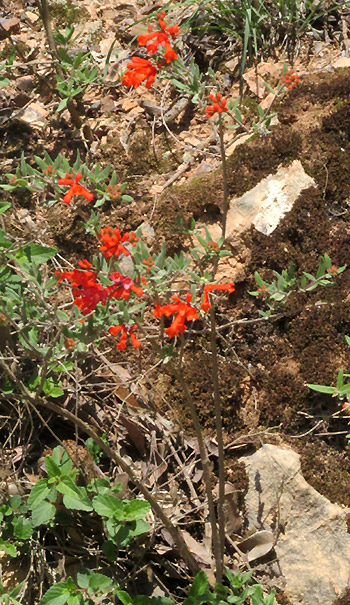 On a steep, rocky slope mostly vegetated with mats of moss and tufts of grass, the woody shrub at the right had lost most of its leaves, probably because of the ongoing, 2-year drought. However, this season's new leaves, and its hummingbird-attracting red flowers seemed to be in good shape. The shrub stood about 1.5m tall (5ft) and was accompanied by three smaller shrubs of its kind scattered along the slope. Here's a closer look at the flowers, which were about 2.5cm long, a little over an inch:
On a steep, rocky slope mostly vegetated with mats of moss and tufts of grass, the woody shrub at the right had lost most of its leaves, probably because of the ongoing, 2-year drought. However, this season's new leaves, and its hummingbird-attracting red flowers seemed to be in good shape. The shrub stood about 1.5m tall (5ft) and was accompanied by three smaller shrubs of its kind scattered along the slope. Here's a closer look at the flowers, which were about 2.5cm long, a little over an inch:
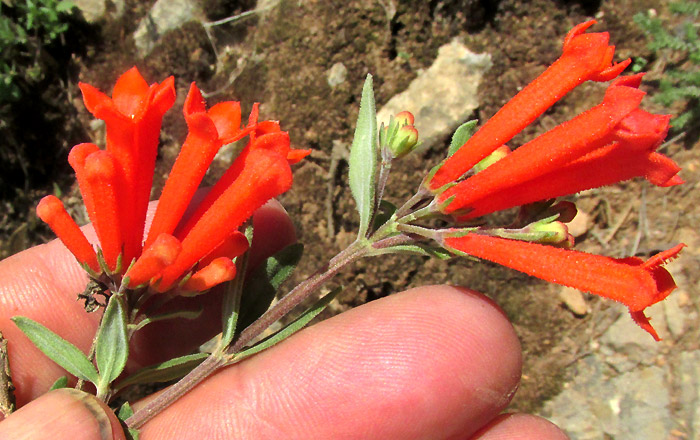
The blossoms were arranged in cyme-type inflorescences, in which the middle blossom opens first, then flowers beside it. The flowers' corollas gradually widened upward, then developed four spreading lobes. All parts pictured are short-hairy. On the corolla lobes of the flower at the above picture's lower, right, it's seen that certain hairs were thick and round-topped, or papillose.
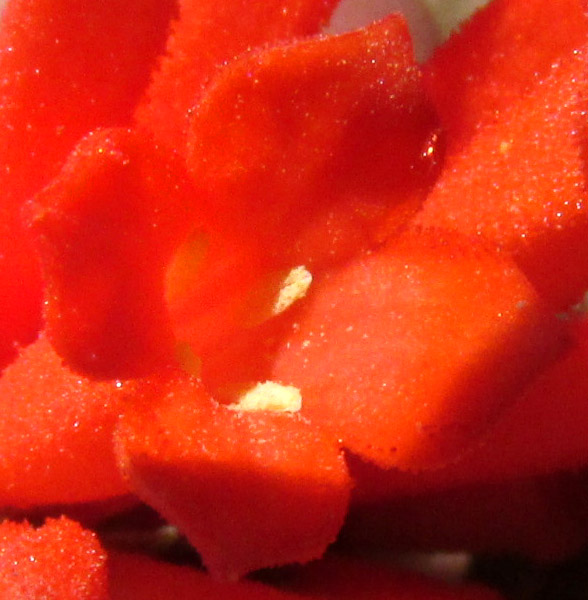
Though a bit hard to see amid all the red, the picture at the left shows a single corolla's open mouth, with sunlight highlighting two of four whitish anthers residing between corolla-lobe bases. The shrub's corollas were all four-lobed, a good field mark, since five lobes are more common. However, the picture below, of a flower's green calyx beside the upside-down, red base of its lifted-off corolla, reveals even more important diagnostic features:
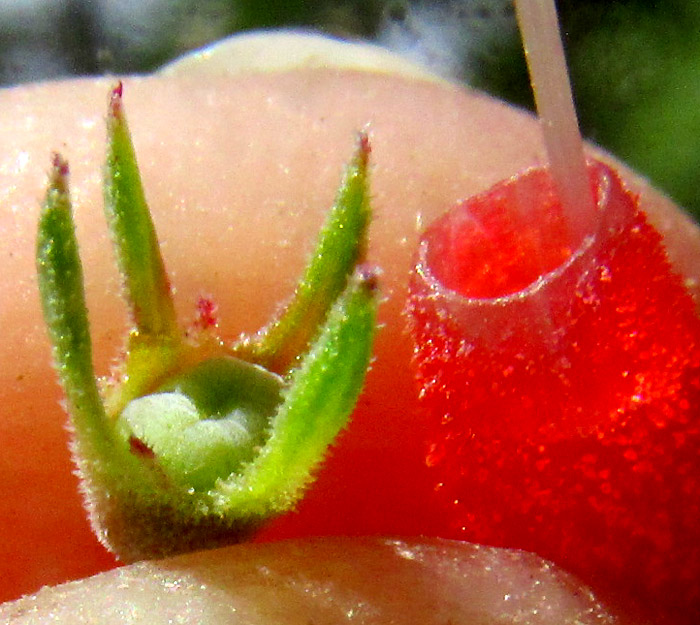
On the picture's left, the pale, doughnut-shaped item is the ovary, the future fruit. Note that the calyx's four tall, slender sepals arise near the ovary's top, not at its base, so this is an inferior ovary, not superior. Earlier, the slender, white style grew from the depression at the ovary top's center. At the picture's right, the broken-off style emerges from the corolla's upside-down base.
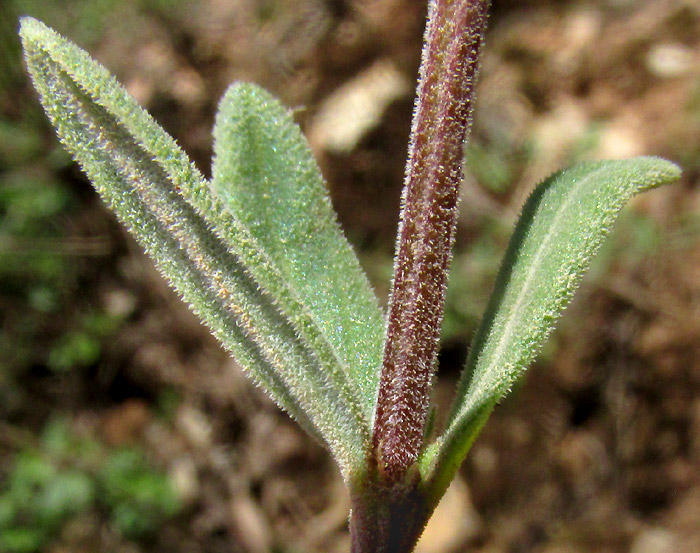
Three short, narrow, white-hairy leaves arose from most stem nodes, instead of the usual one or two, or more than three. Leaf margins were somewhat curled under, which in this species doesn't appear to be the norm, so maybe the leaves were puckering because of the severe drought.
A woody bush with 4-parted flowers and four stamens, inferior ovaries, and usually with three leaves per node, suggests the Coffee or Madder Family, the Rubiaceae. Note the many similarities, but subtle differences, between this bush and one of the most common and conspicuous roadside bushes, also a member of the Coffee Family, ornamenting many of Mexico's tropical lowland roads, the Scarlet-Bush.
The 2002 study by A. Borhidi and N. Diego-Pérez entitled "Inroducción a la Taxonomía de la Familia Rubiaceae en la Flora de México" documented 90 genera embracing more than 540 Coffee-Family species occurring in Mexico. The above features make the family fairly easy to recognize, but determining which species you have of the ~540 candidates can be a challenge. The 2021 work by José Luis Villaseñor and others entitled "Riqueza y distribución de la flora vascular del estado de Hidalgo, México" finds that here in Hidalgo state the Rubiaceae -- a minor family in North America -- is one of the ten most species-rich plant families. Hidalgo hosts 86 documented species.
However, especially because our woody shrub mostly produces three leaves at each stem node, not the two usual for most Rubiaceae, and because its red flowers are larger than in most species, and since its several flowers are arranged in cymes, our plant relatively easily works out to BOUVARDIA TERNIFOLIA. We've seen another attractive native Bouvardia species, the Scented Bouvarida.
The English name of Bouvardia ternifolia, Firecracker Bush, acknowledges both our shrub's cultivation as an ornamental in many gardens worldwide, as well as its natural occurrence in dry, upland parts of Arizona to western Texas in the US, then south through Mexico as far south as Honduras.
Among gardeners, Firecracker Bush is appreciated because it's pretty and "... drought-tolerant and will continue to flower profusely even with minimal water," according to a web page selling it. The shrub is suggested not only for regular gardens but also for planting in mixed containers, and hanging baskets. Several cultivars and hybrids have been developed, including some known for disease resistance. In short, this mostly-Mexican plant has made it big in the world.
It's also a go-to plant in Mexican traditional medicine. The online "Biblioteca Digital de la Medicina Tradicional Mexicana" reports that in central Mexico it's mainly used for snakebite. A tea from its boiled stems and leaves is used to wash the bite, or the plant can be mashed and mixed with the urine of a pregnant woman and applied over the bite as a plaster. The tea also can be used to wash stings of bees, spiders and ants. If you're bruised, chew up some leaves and stems, and paste them atop the bruise. Several other such therapies for a variety of problems are reported. Currently on the Internet a 30ml (1oz) bottle of Firecracker Bush -- marketed under the Spanish name, trompetilla, or "Little Trumpets" -- costs about two US dollars, and is suggested for use against leukemia, cough, dysentery, nerves and general pains.
Noting these traditional uses, the 2015 study by Rubén Román Ramos entitled "Efecto Neuroprotector del Extracto y Fracciones de Bouvardia ternifolia (Cav.) Schltdl." came to this conclusion: "This work shows that B. ternifolia has nootropic, anxiolytic and antidepressant effects, without affecting the spontaneous motility of mice." Nootropic effects are those which enhance memory or other cognitive functions; anxiolytic effects reduce anxiety, and; motility is a general term referring to the ability of a living organism to move independently.
Entry dated March 9, 2024, from notes taken about 2kms west of Higuerillas, Municipality of Cadereyta de Montes; N20.9086°, W99.7865°, elevation ~1760 meters (~5760 feet); on greywacke sandstone cap of hill; area constituting a narrow belt of the extreme southern extension of the Chihuahuan Desert, Meridional Subregion; central Querétaro state, MÉXICO
FIRECRACKER BUSH, DIFFERENT LOOK
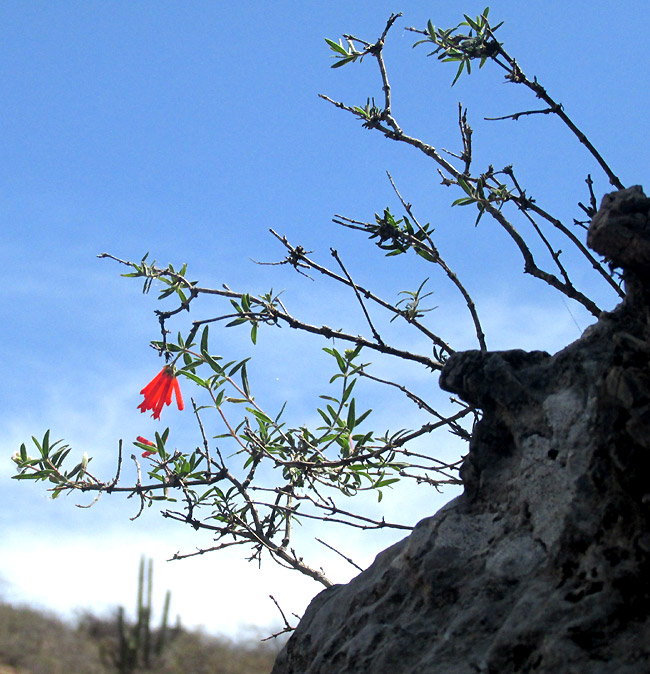
Overhanging a rocky ledge, the above Firecracker Bush prettily displayed the species' unusual flexibility. Unlike the previous bush flowering in September on limestone, this one blossomed in March on sandstone; also, here it was prospering in a climate considerably drier than at the earlier place.
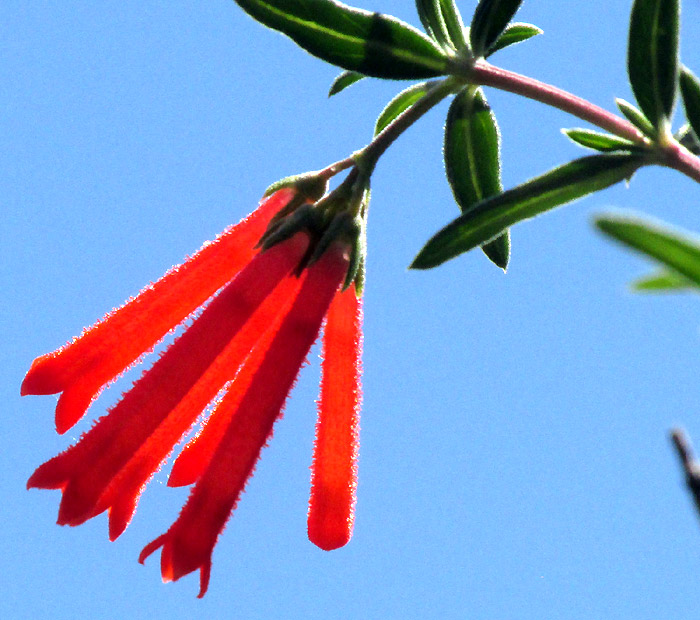
This individual's leaves were a little slenderer than on the earlier plant; most pictures of the species on the Internet show leaves wider than on both of our findings, probably because we've been visiting especially dry places.
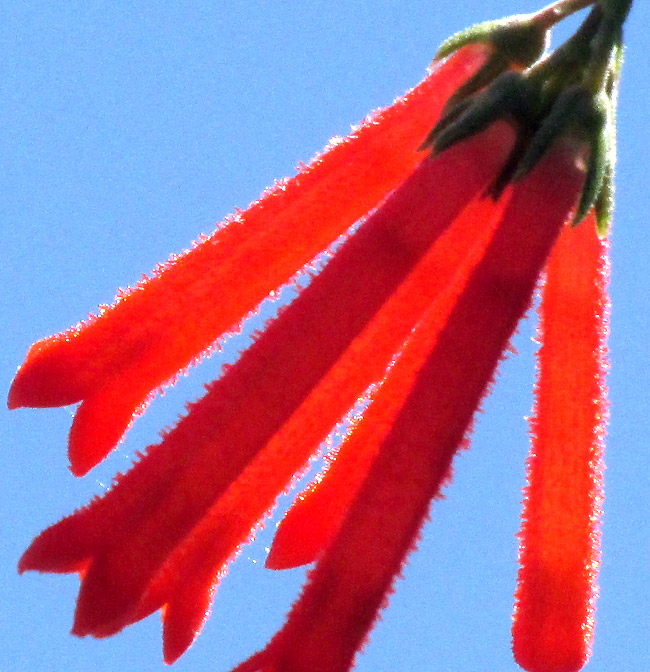
Low-slanting, late afternoon sunlight highlighted the short, gland-tipped hairs covering the corolla's exterior.